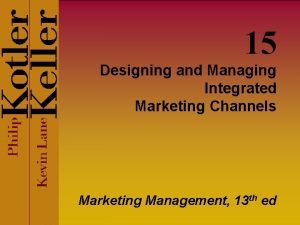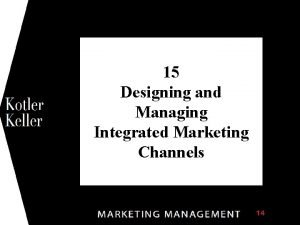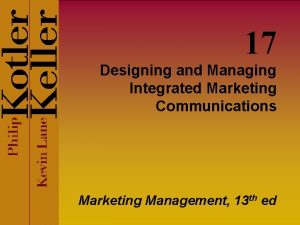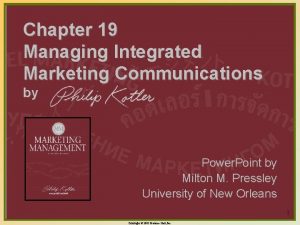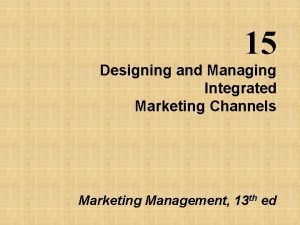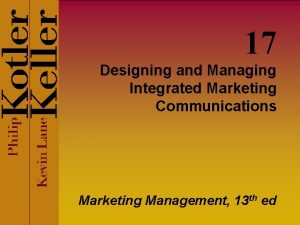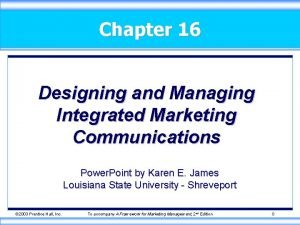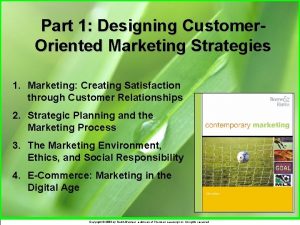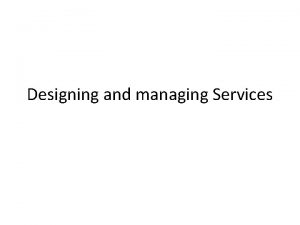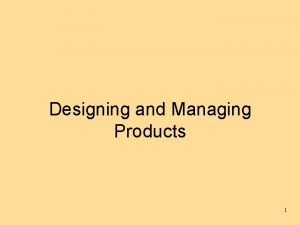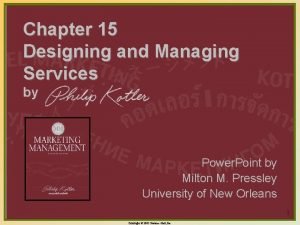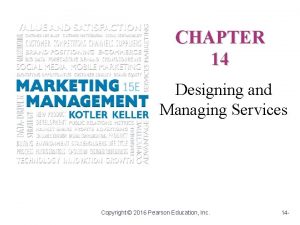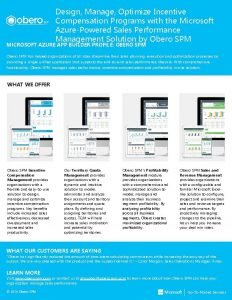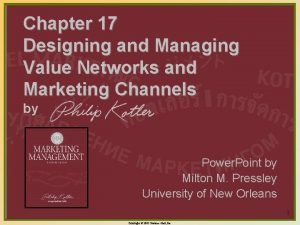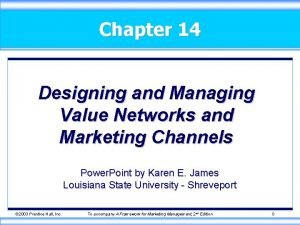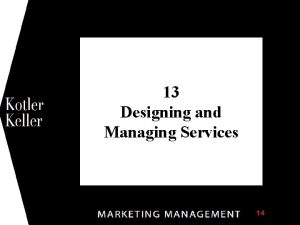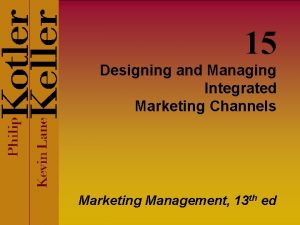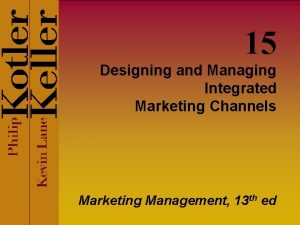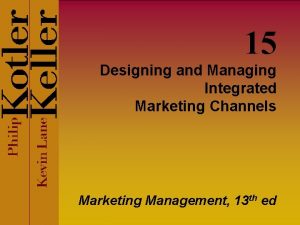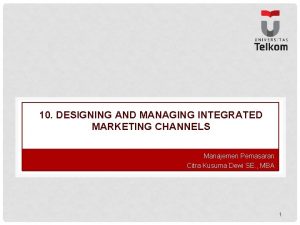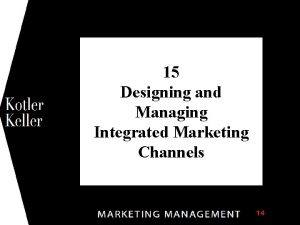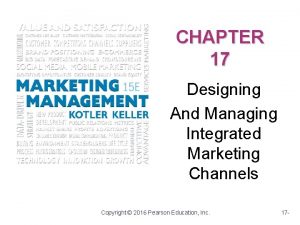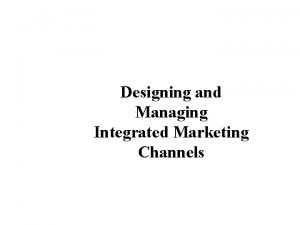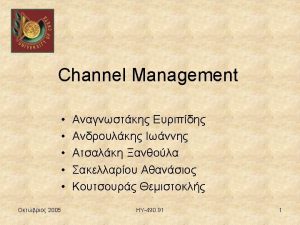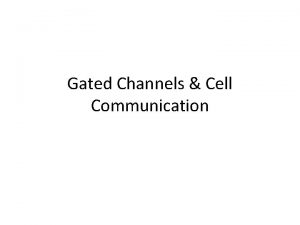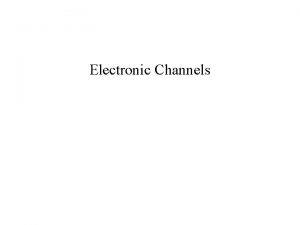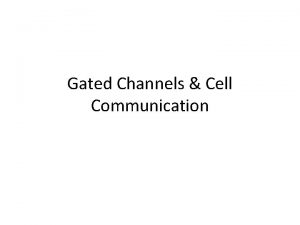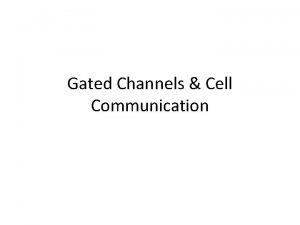15 Designing and Managing Integrated Marketing Channels Marketing



















- Slides: 19

15 Designing and Managing Integrated Marketing Channels Marketing Management, 13 th ed

Chapter Questions • What is a marketing channel system and value network? • What work do marketing channels perform? • How should channels be designed? • What decisions do companies face in managing their channels? • How should companies integrate channels and manage channel conflict? • What are the key issues with e-commerce? Copyright © 2009 Pearson Education, Inc. Publishing as Prentice Hall 15 -2

Push versus Pull Marketing • Push strategy • manufactures uses the sales force, trade promotion money to induce intermediaries to carry, promote & sell product to end user. • Low brand loyalty, • brand choices are made in store, impulse item, well understood benefits Pull strategy-manufacture uses advertising, promotion & other forms of communication to persuade consumers to demand the product from intermediaries. High brand loyalty, high involvement, can perceive difference between brands, chose brand before they go to store

Categories of Buyers Habitual shoppers (same places same manner over time) High value deal seekers (channel surf a great deal before buying at the lowest price) Variety-loving shoppers(gather info from different channels, but buy from their favorite channel) High-involvement shoppers (gather info from all channels, buy from low cost channel, enjoy customer support from high touch channel)

Channel Member Functions • Gather information • Develop and disseminate persuasive communications • Reach agreements on price and terms • Acquire funds to finance inventories • Assume risks • Provide for storage • Provide for buyers’ payment of their bills • Oversee actual transfer of ownership Copyright © 2009 Pearson Education, Inc. Publishing as Prentice Hall 15 -5

Figure 15. 2 Marketing Channel Flows Copyright © 2009 Pearson Education, Inc. Publishing as Prentice Hall 15 -6

Figure 15. 3 Consumer Marketing Channels Copyright © 2009 Pearson Education, Inc. Publishing as Prentice Hall 15 -7

Figure 15. 3 Industrial Marketing Channels Copyright © 2009 Pearson Education, Inc. Publishing as Prentice Hall 15 -8

Designing a Marketing Channel System Analyze customer needs Establish channel objectives Identify major channel alternatives Evaluate major channel alternatives Copyright © 2009 Pearson Education, Inc. Publishing as Prentice Hall 15 -9

Analyzing Customers Channel Service Outputs Lot size (one unit vs. bulk) Waiting/delivery time Spatial convenience (Bata & Exide) Product variety Service backup Copyright © 2009 Pearson Education, Inc. Publishing as Prentice Hall 15 -10

Identifying Channel Alternatives Types of Intermediaries (Direct or multi levels) Number of Intermediaries (Exclusive , Selective, Intensive) Terms and responsibilities (Price, Condition of sales, Distributors territories, Mutual services) Copyright © 2009 Pearson Education, Inc. Publishing as Prentice Hall 15 -11

Number of Intermediaries Exclusive (Shahnawaz/Mercedes Selective (Honda dealers) Intensive (Toothpaste/Candies) Copyright © 2009 Pearson Education, Inc. Publishing as Prentice Hall 15 -12

Figure 15. 4 The Value-Adds vs. Costs of Different Channels Copyright © 2009 Pearson Education, Inc. Publishing as Prentice Hall 15 -13

Figure 15. 5 Break-Even Chart for the Choice Between a Company Sales Force and Manufacturer’s Sales Agency Copyright © 2009 Pearson Education, Inc. Publishing as Prentice Hall 15 -14

Channel-Management Decisions Selecting channel members Training channel members Motivating channel members Evaluating channel members Modifying channel members Copyright © 2009 Pearson Education, Inc. Publishing as Prentice Hall 15 -15

Channel Power • Coercive (Contract) • Reward (Extra benefit) • Legitimate (Expected contractual behavior) • Expert (Expertise) • Referent (Proud association with manufacturer) Copyright © 2009 Pearson Education, Inc. Publishing as Prentice Hall 15 -16

Channel Integration and Systems v Vertical marketing systems • Corporate VMS (Production & distribution, Gourmet) • Administered VMS (Due to size & power of one member like Nestle, UL, P&G) • Contractual VMS (Value Adding Partners) • Wholesaler sponsored • Retailer cooperatives • Franchise organizations v Horizontal marketing systems (UL & Pepsi for bottled Ice-tee) v Multichannel systems (Disney sells DVDs through Blockbusters, Disney stores, Retail stores like Wal. Mart, Amazon. com, Disney catalog)

What is Channel Conflict? • Channel conflict occurs when one member’s actions prevent another channel from achieving its goal. • Types of channel conflict • Vertical (Manufacturer vs. dealer) • Horizontal (Dealer vs. dealer) • Multichannel (Going on line vs. current dealers, Stile doing projects directly) Copyright © 2009 Pearson Education, Inc. Publishing as Prentice Hall 15 -18

Causes of Channel Conflict Goal incompatibility Unclear roles and rights Differences in perception Intermediaries’ dependence on the manufacturer Copyright © 2009 Pearson Education, Inc. Publishing as Prentice Hall 15 -19
 High value deal seekers
High value deal seekers Integrated marketing channel system
Integrated marketing channel system Designing and managing integrated marketing channels
Designing and managing integrated marketing channels Designing and managing integrated marketing communications
Designing and managing integrated marketing communications Designing and managing integrated marketing communications
Designing and managing integrated marketing communications Designing and managing marketing communications
Designing and managing marketing communications Designing and managing integrated marketing communications
Designing and managing integrated marketing communications Marketing environment framework
Marketing environment framework What is channel design in marketing
What is channel design in marketing Channel design decisions steps
Channel design decisions steps Why designing and managing service processes
Why designing and managing service processes Managing products and brands
Managing products and brands Designing and managing services
Designing and managing services Services are typically produced and consumed simultaneously
Services are typically produced and consumed simultaneously Obero spm
Obero spm Designing and managing value networks
Designing and managing value networks What is a marketing channel system and value network
What is a marketing channel system and value network Designing and managing value networks
Designing and managing value networks How to designing and managing service processes
How to designing and managing service processes Designing and managing services
Designing and managing services
